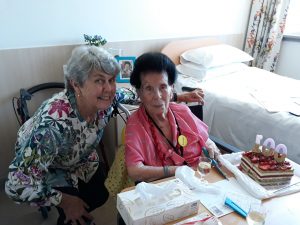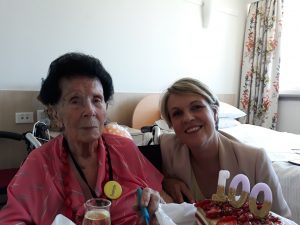by Janice Challinor, March 2022, from Bulletin 1/2022
100th birthday of Sarah (Sadie) Murdoch King
Sadie moved to full time care at Elizabeth Lodge, 46 Bayswater Rd, Rushcutters Bay on 8 December 2021, nine days before her long anticipated 100th Birthday celebration. Disappointingly (but understandably), due to Omicron concerns, the facility did not sanction Sadie’s day out to Glebe Town Hall to celebrate her 100th birthday on 17 December. Fortunately, the Hon. Tanya Plibersek, Sadie’s long-time friend, was able to visit her at Elizabeth Lodge on the day to present Sadie with the many birthday wishes she received; including from Her Majesty Queen Elizabeth II, the Australian Governor General, His Excellency the Hon. David Hurley, the Australian Prime Minister, the Hon. Scott Morrison, and the Premier of NSW the Hon. Dominic Perrottet among many others. I was entrusted with taking her birthday cake, provided by the Glebe Society, and good wishes from Glebe to her (see photos below). Sadie’s room was bedecked with flowers, gifts and cards, which complemented her many certificates and service testaments, reminding us of Sadie’s lifetime commitment to the community. We toasted Sadie’s milestone. With these celebrations, Sadie’s desire to celebrate did eventuate, but not in the form I had hoped for her.
Sadie’s well-known Labor Party and Union acquaintances and friends who’d accepted the invitation included John Faulkner, Meredith Burgmann, Linda Scott, and Col Joye. Others who’d accepted were long-term friends from Sadie’s religious affiliations and the Glebe community including Lyn Milton, Paul Graham, Barbara Brilley, Jenny McNaughten and her daughter Sarah, Jamie Parker, Jess Scully, Paul Perini, Margaret Sankey, Kay White, Bruce Chee, Lisa Yardley, John and June Ebert. These 65 people were no doubt disappointed at being unable to congratulate Sadie in person on the day.


Valé Sarah (Sadie) Murdoch King (17 December 1921 – 17 January 2022)
Born in Glasgow, Scotland in 1921 Sadie moved to Australia in 1926 at the age of 4 ½ with her parents. Unfortunately, her mother was killed in an automobile accident the year following their arrival. As a sole parent, Sadie’s father, George, struggled to support Sadie, but in 1929 when he lost his job due to the Depression he could no longer do so, and reluctantly put her into the care of Burnside Children’s Homes at North Parramatta. In 1931 Sadie developed osteomyelitis which, prior to penicillin, was a serious and painful disease. She spent over eight months in hospital and three years in rehabilitation at Canonbury at Darling Point. During her admission to the District Hospital in Parramatta, Sadie saw the letters ‘PDH’ above the door. In her young and fearful mind, she thought they stood for ‘Please Die Here’. She recovered and returned to Burnside, albeit with callipers and a pronounced limp. The legacy of this childhood disease came back to trouble Sadie as ongoing pain in her final months.

At nearly 17 years of age Sadie returned to live with her father on the Central Coast. During the Depression, George and a friend had begun a branch of the Unemployed and Relief Workers Association there. No doubt Sadie’s working-class values, and later on, workplace activism, had its roots in this experience. She undertook a variety of jobs there then left home to work at Jenolan Caves House. With the onset of WWII, Sadie moved to Katoomba and worked at the Lithgow Small Arms Factory. Her father joined her there but died suddenly on his way to work one day in 1944, by which time Sadie had moved to St Marys to work at the Munitions Factory, something she described as ‘difficult and dirty work’. She met American Servicemen in Katoomba, many of whom were patients at the Hydro-Majestic, commandeered as a US Military hospital: ‘Everyone in Katoomba knew that most of them had venereal diseases’, she noted pointedly. She also met an Australian ‘flyboy’ from nearby Richmond Airforce base, and very uncharacteristically confided that he may have been the ‘love of her life’, but nothing further.
At war’s end, Sadie migrated to Sydney looking for work. She arrived in Glebe, living at first in a Church of England boarding house for young women, then later as a tenant on the Glebe Estate. Initially she worked in Glebe at several factories and then with the Egg Board. Sadie then decided to take the Public Service entry exam and, on passing, was employed at Sydney GPO as a mail sorter. After only a few months she was retrenched, something she’d been warned might happen if a returning serviceman needed her job. She and other women who were similarly affected appealed to the Commonwealth Public Service Board and won. Upon reinstatement, Sadie trained as an accounting machinist in the Finance and Accounting Department where she remained until her retirement.
It was that experience that motivated her to become a union representative in the workplace, and later she became the first woman to be elected to the Australian Post and Telecommunications Union (now the CEPU) executive. She also joined the Glebe Branch of the NSW Labor Party in which she became the vice-president to Peter Thom in the early 1970s. She was active in workplace and local politics for many years, working essentially to promote the rights of workers – and particularly women workers – to fair conditions and equal pay. She became a Councillor and attended meetings at Sussex St right up until the end of the last millennium.
By the early 1970s the Church of England was unable to maintain its public housing properties in Glebe due to insufficient income, largely due to rent control. They were looking to dispose of their properties to private developers. At the same time, the NSW State Government’s threat to carve two expressways through Glebe was also causing great concern in the community. It was the combined lobbying of individuals and organisations that led the newly-elected Whitlam Government to purchase the Glebe Estate in 1974, thus saving both public housing and heritage buildings. Sadie was involved in this community action and subsequently became a member of the Residents Advisory Committee, set up by the Glebe Project to consult on the refurbishment of the Glebe Estate.
Apart from her workplace and political activism, Sadie was also engaged in community support through her religious affiliations. She went regularly to the Wesley Mission where she supported Lifeline, as well as Christ Church St Lawrence where she volunteered in their drug rehabilitation program. As a JP from 1972. she assisted local people who needed help navigating bureaucratic hurdles.
Upon retirement from the GPO at the end of 1984, Sadie took a long-awaited trip to Scotland and Ireland, the lands of her forebears then, on returning to Glebe continued to work for the community. Due to her life-long activism Sadie received many accolades, including the Queen’s Jubilee Medal in 1977, an Australia Post Medal in 1981, the Medal of the Order of Australia in 1985, Life Membership of the APTU in 1985 and in 2009, Life Membership of NSW Labor. It is no wonder then that when I asked Sadie about marriage, she replied that the amount of time she’d spent at meetings and pursuing the Labor cause would have been unacceptable to any partner. She was in her words ‘an ardent lover of animals’ and always had a moggy. Her last two included Robbie, named for the great Scottish bard and Lawson for the Australian balladeer.
Sadie lived in Glebe right through the last two years of COVID lockdowns with the assistance, care and attention of her good friend and neighbour Mr Paul Graham. Sadie would not have been able to stay in her home for so long without his help. She was hospitalised in early November after a fall, then moved into full time care at Elizabeth Lodge, 46 Bayswater Rd, Rushcutters Bay on 8th December 2021.
Sadie’s life ended quietly and peacefully there one month after her 100th birthday.
In farewelling this remarkable woman, someone who is an icon of Glebe; someone who was lovingly referred to as the ‘Queen of Glebe’ by those who knew her best, may we say Rest in Peace. Vale Sadie.








2 comments. Please add yours.
What a fascinating account of a truly remarkable woman.
Thank you for sharing.
Beautiful Sadie ❤️ Knew her all my life xxx